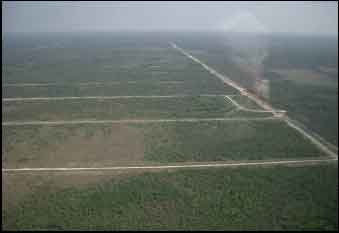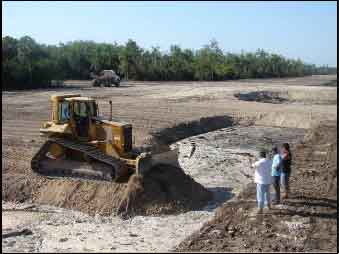by Anthony (Tony) Marx

Aerial photo of the “south blocks” in the Picayune by Marya Repko taken several years ago.
Once considered as useless and a noxious, snake and insect infested source of fevers which must be drained and developed, half of the wetlands that existed at Florida Statehood have been destroyed. However Collier County is blessed with over 72% of its land acreage designated as conservation land – more than twice that of neighboring counties.
There is a stark difference between the 85,000-acre Fakahatchee State Preserve and the adjoining Picayune State Forest, which at 78,000 acres is almost as large. The Fakahatchee is a vibrant, natural world pulsating with life and home to a huge variety of rare plant life and endangered animals; whereas the Picayune, once also a similar wetland, was logged, cleared and partially developed, then abandoned. This transformed it into a dry landscape with upland trees and vegetation. Non-native vegetation including Brazilian Pepper, always present when land is disturbed, also moved in. Over two hundred miles of elevated roads acted as levies to further stop natural water flow between the canals. The difference is most noticeable when you access the Picayune State Forest through its back entrance at the end of Janes Scenic Drive in the Fakahatchee State Park. Outdated maps show a grid of streets which are mostly non-existent. The massive Comprehensive Everglades Restoration Plan (CERP) is changing the landscape in every respect. The bridge, on entering over the former Prairie has gone and the canal plugged, so it is now a series of small ponds.

Photo of equipment filling in a canal by Dennis Giardina.
Heading west, the partial dirt and paved road still shown on maps as Stewart has been leveled flat with the surrounding landscape, and on either side large swathes of scrub have been bulldozed clear of all vegetation and leveled to start sheet water flowing. Progress is occasionally blocked at the next canal bridge, but if you can proceed you’ll find that the formerly paved Everglades Boulevard section leading to Naples has also had its surface removed and the last time I was there it was gated closed. Heavy equipment is seen working here and there, bulldozing and trucking away debris. Close to I-75 instead of water flowing south down canals to the estuaries, the new and powerful pumping stations under construction will send water flowing fanlike south through spreader channels in an east-west direction while the remaining three canals running north to south will be plugged to varying degrees.

Boulevard in the Picayune taken by Tony Marx in 2011.
If you plan to try and reach Naples from the Picayune be prepared to turn back, as the road may be blocked by either a closed gate or sheet water in summer. In time it will return to a wetland environment and the interior will be mostly be inaccessible to vehicles. The full transformation will take several decades but soon the Fakahatchee will benefit from the additional water flowing southeast.
Tony Marx is a Florida Master Naturalist and a Board Member of Friends of Fakahatchee. He was one of the speakers at our Annual Dinner on April 13.
